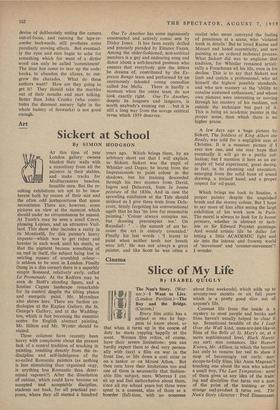Art
Sickert at School
HOD GSON By SIMON
AT this time of year London gallery owners blanket their walls with a miscellany from all the painters in their stables, and make tracks for Mediterranean beaches. Sensible men. But the re- sulting exhibitions are apt to be inco- herent both by reason of their size and the often odd juxtapositions that space necessitates. There are, however, some pictures on view at the moment which should under no circumstances be missed. At Tooth's may be seen a small Corot, pleasing Lepines, and an attraotive Vuil- lard. This show also includes a rarity in its Monticelli, for this painter's heavy impasto—which was to get richer and heavier in each work until his death, so that the pigment became something of an 'end in itself, the subject being lost in swirling masses of scumbled colour— is seldom to be seen in London. Finally (hung in a dim corner) there is a superbly simple Bonnard, relatively early, called La Promenade. At the Redfern may be seen de Sta61's standing figure, and a Soutine Cagnes landscape remarkable for its control despite the tilting planes and energetic paint. Mr. Moynihan also shows here. There are further an- thologies at the Kaplan Gallery, the St. George's Gallery, and at the Wadding- ton, which is fast becoming the essential centre for English abstract painting, Mr. Hilton and Mr. Wynter should be visited.
These columns have recently been heavy with complaints about the present lack of a central tradition of teaching in painting, resulting directly from the in- discipline and self-indulgence of the so-called Romantic painters (as nothing is less stimulating than organised orgy, is anything less Romantic than deter- mined vapours?). After the dissolution of cubism, which could have become an accepted and acceptable discipline, students are back, for all practical pur- poses, where they all started a hundred
years ago. Which brings them, by an arbitrary short cut that I will explain, to Sickert. Sickert was the pupil of Whistler and Degas; he learnt from the Impressionists to paint colour in the shadows, but his training descended through his two masters from David, Ingres and Delacroix, from /a bonne peinture of the 1830s. And in case the sprawling exhibition at the Tate should mislead us I give three texts from Dela- croix, firmly forgetting his conversational squib that he has 'no love for reasonable painting.' Colour always occupies me, but drawing preoccupies me.' On Ruysdael: . . the summit of art be- cause the art is entirely concealed.' Finally his last words : 'I learnt to paint when neither teeth nor breath were left.' He was not always a great painter, and like Scott he was often a
realist who never conveyed the feeling of prescience at a scene, who 'violated truth in details.' But he loved Racine and Mozart and hated eccentricity, and saw painting as an ordered technical process. What Sickcrt did was to anglicise that tradition, for Whistler remained artisti- cally a Frenchman all his life, even in his decline. This is to say that Sickert was limb and cuticle a professional, who set himself the highest possible standards, and who saw mastery as the 'ability to canalise sustained enthusiasm,' and whose own pictures were interesting or moving through his mastery of his medium, not outside the technique but part of it. This is being an academic painter in the proper sense, than which there is no higher praise.
A few days ago a huge picture by Sickert, The Soldiers of King Albert the Ready, was sold for a negligible sum at Christies. It is a museum picture if I ever saw one, and one may hope that eventually it will go to a public col- lection; but I mention it here as an ex- ample of bold experiment, great daring, in fact, in its planning and execution, emerging from the solid basis of sound drawing, a trained hand, and a proper respect for oil-paint.
Which brings me back to Soutine, a proper painter despite the anguished brush and the stormy colour. But I hope to say more of him after seeing the large exhibition of his work now in Paris. The moral is always to look for la bonne peinture, whether in abstract or tach- iste or Sir Edward Poynter paintings. And would artistic life be duller for letting a little ACADEMIC light and air into the intense and frowsty world of `movement' and 'counter-movement'? I wonder.


























 Previous page
Previous page